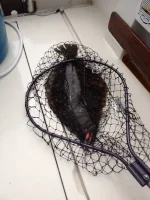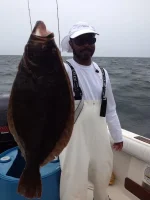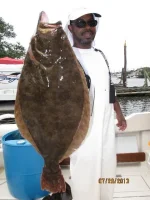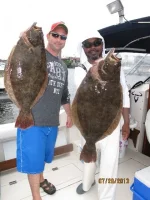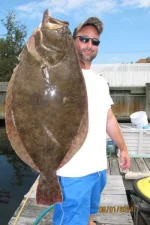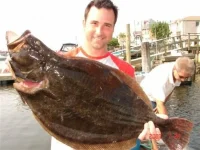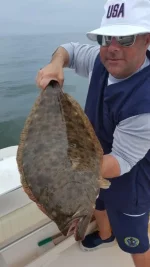NYSharpie
New Angler
As with most fish, being able to catch them as an angler is fun, but being the one who puts the crew on the meat and seeing the boat get and stay on a bite takes it to the next level for me! I wanted to start a thread on strategies for finding a body of Fluke and techniques for staying on the meat. On our boat we are pretty serious about fluke, and something we do pretty well (at least sometimes  .
.
Over time, we have increased our knowledge of hard bottom, reefs, ledges, holes, and sandy flats that catch nice Fluke. Personally, my crew favors the hard bottom where we donate many jigs in exchange for some real quality fish.
I love to scope out an area using my machines (Garmin 7610 is what we have on our boat), work the bottom, and zone in on 1-2 specific drift lines that are producing. Sometimes our drifts are long, other times very short. Another challenge is calculating for ever changing drift conditions; which my good buddy Savvy18 gets on me for "missing the mark!" LOL. One of our best drops is right in the middle of a few conflicting currents, and the time the fish are usually biting is at the end, slack and turn of the tide. This, with varying wind conditions at that time, results in some pretty precise estimation to get over the "X." Either way, I get a real thrill over this aspect of fishing.
This, paired with the right bait selection, color, lure size, jig type, etc... has all resulted in our main crew putting some nice fish in the boat year after year. Like anything else with this sport, however, there is still much to learn. One thing I have learned is to change with the trends. Staying stubborn on the same exact drop that used to be "lights out," will leave you chasing an empty dream.
I also love keeping a record as to what weeks, water temps, etc.. are good for certain drops and try to follow those patterns year after year.
I would love to get the groups perspective on this aspect of running the boat to catch Fluke.
Frank
Over time, we have increased our knowledge of hard bottom, reefs, ledges, holes, and sandy flats that catch nice Fluke. Personally, my crew favors the hard bottom where we donate many jigs in exchange for some real quality fish.
I love to scope out an area using my machines (Garmin 7610 is what we have on our boat), work the bottom, and zone in on 1-2 specific drift lines that are producing. Sometimes our drifts are long, other times very short. Another challenge is calculating for ever changing drift conditions; which my good buddy Savvy18 gets on me for "missing the mark!" LOL. One of our best drops is right in the middle of a few conflicting currents, and the time the fish are usually biting is at the end, slack and turn of the tide. This, with varying wind conditions at that time, results in some pretty precise estimation to get over the "X." Either way, I get a real thrill over this aspect of fishing.
This, paired with the right bait selection, color, lure size, jig type, etc... has all resulted in our main crew putting some nice fish in the boat year after year. Like anything else with this sport, however, there is still much to learn. One thing I have learned is to change with the trends. Staying stubborn on the same exact drop that used to be "lights out," will leave you chasing an empty dream.
I also love keeping a record as to what weeks, water temps, etc.. are good for certain drops and try to follow those patterns year after year.
I would love to get the groups perspective on this aspect of running the boat to catch Fluke.
Frank

